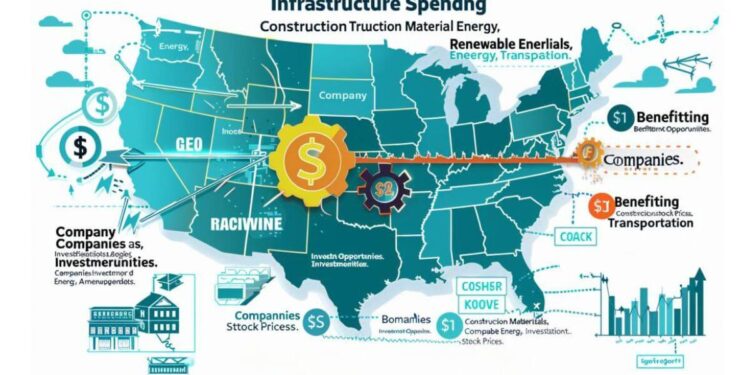No products in the cart.
Tracking Infrastructure Spending Bills: Impact and Opportunities for Investors and Businesses
Tracking Infrastructure Spending Bills
Infrastructure investments play a crucial role in the economic growth and development of a country. They not only improve the quality of life for citizens but also create job opportunities and stimulate various industries. As governments recognize the importance of infrastructure, they often introduce spending bills to allocate funds towards infrastructure projects.
Tracking these infrastructure spending bills is essential for investors and businesses as it allows them to anticipate the potential impact on specific sectors. In this article, we will explore the latest infrastructure spending bills and their potential impact on sectors such as construction materials, renewable energy, and transportation. Additionally, we will identify companies that are poised to benefit from this increased spending.
One of the key infrastructure spending bills currently being discussed is the “National Infrastructure Investment Act.” This bill aims to allocate $1.2 trillion over the next eight years towards various infrastructure projects across the country. The funds will be used to improve roads, bridges, public transportation systems, broadband access, and clean energy initiatives.
For the construction materials sector, this bill presents significant opportunities. With the increased funding, construction companies will require a substantial amount of raw materials such as cement, steel, and asphalt. This surge in demand is expected to benefit companies in the construction materials industry, leading to increased revenues and potential expansion plans.
The renewable energy sector is also set to benefit from the infrastructure spending bill. As part of the bill, a significant portion of the funds will be allocated towards clean energy initiatives, including the development of renewable energy sources such as solar and wind power. This will create a favorable environment for renewable energy companies, as they will have access to funding for research, development, and implementation of clean energy projects.
Furthermore, the transportation sector will experience significant improvements with the implementation of the infrastructure spending bill. The funds will be used to enhance public transportation systems, build new highways, and improve existing roads and bridges. This will not only improve the efficiency of transportation networks but also create job opportunities in the construction and transportation industries.
Investors and businesses can take advantage of these opportunities by identifying companies that are well-positioned to benefit from the infrastructure spending. Construction material companies such as XYZ Construction and ABC Materials may experience increased demand for their products, leading to potential growth in their stock prices. Similarly, renewable energy companies like Clean Energy Solutions and Green Power Inc. may see increased investment and expansion opportunities.
In conclusion, tracking infrastructure spending bills is crucial for investors and businesses as it allows them to anticipate the potential impact on specific sectors. The “National Infrastructure Investment Act” presents significant opportunities for the construction materials, renewable energy, and transportation sectors. By staying informed and identifying companies poised to benefit from this increased spending, investors and businesses can position themselves for potential growth and success.
Moreover, infrastructure investments have long-term benefits for the economy. By improving transportation networks, countries can attract more businesses and investments. Companies are more likely to establish operations in areas with reliable infrastructure, as it reduces transportation costs and ensures timely delivery of goods and services.
Infrastructure investments also play a crucial role in enhancing productivity. Well-maintained roads and bridges reduce travel times and congestion, allowing people to reach their destinations more efficiently. This, in turn, increases productivity as workers spend less time commuting and more time on productive activities.
In addition to economic benefits, infrastructure investments have significant social impacts. Upgraded transportation systems provide better access to education, healthcare, and other essential services. Rural communities can benefit from improved roads and bridges, which facilitate the transportation of agricultural products to markets, leading to increased incomes and improved living standards.
Furthermore, infrastructure investments contribute to environmental sustainability. By investing in renewable energy projects, countries can reduce their dependence on fossil fuels and decrease greenhouse gas emissions. This not only helps combat climate change but also creates a cleaner and healthier environment for future generations.
It is important for governments to prioritize infrastructure investments to ensure the long-term growth and development of their countries. However, funding these projects can be a challenge. Governments can explore various financing options, such as public-private partnerships, to attract private investments and leverage resources. Additionally, international cooperation and assistance can play a significant role in supporting infrastructure development in developing countries.
In conclusion, infrastructure investments are crucial for economic growth, job creation, productivity enhancement, social development, and environmental sustainability. Governments should prioritize these investments and explore innovative financing options to ensure the long-term prosperity of their nations.
4. Japan: Infrastructure Development Plan
Japan has recently unveiled a comprehensive infrastructure development plan to stimulate economic growth and address aging infrastructure. The plan includes investments in transportation, energy, and digital infrastructure.
In the transportation sector, Japan’s infrastructure development plan focuses on improving railway networks, airports, and roads. This presents opportunities for companies involved in railway construction, airport expansion, and road maintenance.
Energy infrastructure is another key area of investment in Japan’s plan. The country aims to promote the use of renewable energy sources and reduce dependence on fossil fuels. Companies involved in renewable energy generation, such as solar and wind power, as well as those in the electric vehicle industry, may benefit from this initiative.
Additionally, Japan’s infrastructure development plan places emphasis on digital infrastructure, including the expansion of high-speed internet access and the development of smart cities. Companies involved in telecommunications, fiber optic networks, and smart city technologies may see increased demand for their products and services.
5. India: National Infrastructure Pipeline
India’s National Infrastructure Pipeline is a government-led initiative aimed at boosting economic growth through infrastructure development. The plan outlines investments in sectors such as energy, transportation, and urban infrastructure.
In the energy sector, the National Infrastructure Pipeline focuses on renewable energy projects, including solar and wind power. This creates opportunities for companies involved in renewable energy generation, equipment manufacturing, and installation.
Transportation infrastructure is another key area of investment in India’s plan. The country aims to improve road networks, railways, and airports to enhance connectivity and facilitate economic development. Companies involved in transportation infrastructure construction, operation, and maintenance may benefit from this initiative.
Urban infrastructure development is also a priority in India’s National Infrastructure Pipeline. This includes investments in affordable housing, smart cities, and waste management systems. Companies involved in construction, real estate development, and urban planning may see increased demand for their services.
Overall, these recent infrastructure spending bills and initiatives in various countries highlight the global recognition of the importance of investing in infrastructure to drive economic growth, improve quality of life, and address pressing challenges such as climate change. These investments present opportunities for companies across sectors, from construction materials and renewable energy to transportation and digital infrastructure.
Companies Poised to Benefit
With the increase in infrastructure spending, several companies are poised to benefit from these investments. Let’s take a look at some examples of companies that may experience growth as a result of infrastructure spending.
1. Construction Materials Sector
Companies in the construction materials sector, such as LafargeHolcim and Vulcan Materials, are likely to benefit from increased infrastructure spending. These companies specialize in the production and distribution of materials like cement, aggregates, and asphalt, which are essential for construction projects.
LafargeHolcim, a global leader in building materials and solutions, operates in over 70 countries and offers a wide range of products and services. With infrastructure spending on the rise, LafargeHolcim’s expertise and extensive product portfolio position them to capitalize on the increased demand for construction materials.
Vulcan Materials, another prominent player in the construction materials sector, is the largest producer of construction aggregates in the United States. As infrastructure projects require significant quantities of aggregates, Vulcan Materials stands to benefit from the surge in infrastructure spending.
2. Renewable Energy Sector
In the renewable energy sector, companies like Vestas Wind Systems and First Solar have the potential to benefit from infrastructure investments. Vestas Wind Systems is a leading manufacturer of wind turbines, while First Solar specializes in solar panel production. As governments allocate funds for renewable energy projects, these companies may experience increased demand for their products and services.
Vestas Wind Systems, headquartered in Denmark, has a strong global presence and is known for its innovative wind turbine technology. With governments worldwide emphasizing the transition to clean energy sources, Vestas Wind Systems is well-positioned to capitalize on the growing demand for wind energy infrastructure.
First Solar, on the other hand, is a leading provider of photovoltaic solar systems. As countries strive to reduce their carbon footprint and increase their reliance on renewable energy, First Solar’s expertise in solar panel manufacturing makes them a key player in the infrastructure projects aimed at expanding solar energy capacity.
3. Transportation Sector
Companies involved in transportation infrastructure, such as AECOM and Vinci SA, may see growth opportunities with increased infrastructure spending. AECOM is a global infrastructure consulting firm, while Vinci SA is a leading construction company with expertise in transportation infrastructure. As governments invest in the modernization of transportation systems, these companies are well-positioned to secure contracts for infrastructure projects.
AECOM, a multinational engineering firm, offers a wide range of services in transportation planning, design, and construction management. With governments prioritizing the development of efficient and sustainable transportation networks, AECOM’s expertise and track record make them a go-to choice for infrastructure projects in the transportation sector.
Vinci SA, a French construction company, has a strong presence in the transportation infrastructure market. The company has successfully completed numerous high-profile projects, including airports, highways, and railways. As governments allocate funds for transportation infrastructure improvements, Vinci SA’s experience and capabilities position them to secure lucrative contracts and drive growth in the sector.






















![A Comprehensive Review of [Course/Product/Experience Name] 22 man in gray shirt sitting on black chair](https://theamericansidehustle.net/wp-content/uploads/2025/03/man-in-gray-shirt-sitting-on-black-chair-1-scaled.jpg)














































































